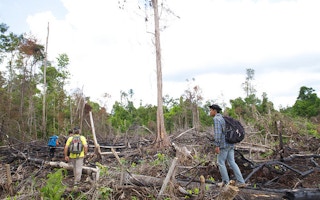Debates over forest loss in Borneo generally focus on the extent to which industrial plantations are to blame: those on the conservation side charge oil palm and pulp and paper for the destruction of tropical rainforest, those on the plantation side tend to argue that planting is done on already deforested land.
Until now, both sides have lacked clear evidence to justify their claims.
“The story is complex, drivers of deforestation are many. Until now we lacked information to distinguish so-called good and bad plantations,” said Douglas Sheil of the Norwegian University of Life Science.
In a new study published in Scientific Reports that he co-authored, Sheil and fellow scientists reviewed over 400 Landsat satellite images of Borneo between 1973 and 2015 to track forest loss and degradation and the concomitant expansion of plantations. The impacts of drought and fires tied to El Nino events were also considered.
According to the study, 76 per cent, or 55.8 million hectares, of Borneo was old-growth rainforest in 1973. The scientists determined that approximately 18.7 million hectares of forest was cleared between 1973 and 2015, and that industrial plantations expanded by 9.1 million hectares.
“
Despite planting on degraded lands, deforestation remains very high in Indonesia and Malaysia, and does not appear to be slowing.
David Gaveau, scientist and lead author of the study, CIFOR
By 2015, 50 per cent of the island shared by Malaysia, Indonesia and Brunei remained forested , with 28 per cent old-growth rainforest and 12 per cent covered in industrial plantations.
“We calculated the delays between deforestation and the establishment of industrial tree plantations. We reasoned that, as a statistical generalisation, industrial plantations developed rapidly after forest clearance are responsible for that clearance, while the longer the delay the more likely such plantings are avoiding direct deforestation,” said Center for International Forestry Research (CIFOR) scientist and lead author of the study David Gaveau.
Making comparisons
The study found contrasting patterns between Indonesia and Malaysia’s rate of conversion, i.e. the amount of time between deforestation and development. In Malaysia, rapid conversion to plantations has been greater, at 57-60 per cent of all deforestation since 1973, while Indonesia’s was at 15-16 per cent.
“Of the 15-16 per cent of deforestation in Kalimantan associated with rapid conversion to industrial plantations, 11-13 per cent is attributed to oil palm. What this shows is that the majority of oil palm plantations were developed on degraded lands, meaning forests converted to ferns, grasslands and scrubs by drought and recurrent burning, mainly during El Nino years,” Gaveau said in a presentation at the 2016 Annual Meeting of the Association for Tropical Biology and Conservation.
That so many oil palm plantations in Kalimantan were developed on fire-induced deforested land offers much nuance in the debate over whether oil palm is the main driver of deforestation in the region.
“People have been arguing that plantations should be developed on degraded lands, and what we found – with caveats – is that in Kalimantan in Indonesia that is largely what has been happening,” Sheil said. In Malaysia, on the other hand, the study suggests that the plantation industry was the principle driver of the loss of forest because of the speedy rate of conversion.
Seen from that perspective, Indonesia seems to have done much better than has been widely assumed.
But, the scientists found something changed in 2005.
“Since 2005, Kalimantan experienced a boom in plantation development. Over half of the existing plantations were added since then, and there has been a steep increase in the rapid conversion of forests to plantations, Kalimantan becoming the principle contributor of rapid net forest conversion by area. Despite planting on degraded lands, deforestation remains very high in Indonesia and Malaysia, and does not appear to be slowing,” Gaveau said.
“More needs to be done to protect Borneo’s forests,” he added.
Hot topic
Underscoring the complexity of the deforestation process is essential, especially amid increasing calls for boycotts of palm oil products.
“Oil palm expansion has accelerated over time, and expands in different local contexts. As such, this expansion takes over different land uses ranging from forests, agroforestry systems and degraded lands. This study confirms these diverse land use dynamics linked to oil palm expansion,” said Pablo Pacheco, principal scientist at CIFOR and co-author of the study.
It is no longer possible to generalise about oil palm trajectories and likely outcomes.
“Oil palm is not always a bad thing,” Sheil said. “It generates a sizeable amount of revenue for people and is very efficient in generating incomes from limited land. I worry that we are stigmatising an entire crop – but it’s not the crop that is the problem but where we grow it.”
Study co-author Erik Meijaard of the Borneo Futures Project said facts such as those provided by the study are much needed in the debate over extractive industries.
“Oil palm is so polarised between camps that love it or hate it with a vengeance. There is much that has not been quantified with regard to oil palm development and causal relationships,” he said.
This story was published with permission from CIFOR. Read the full story.










